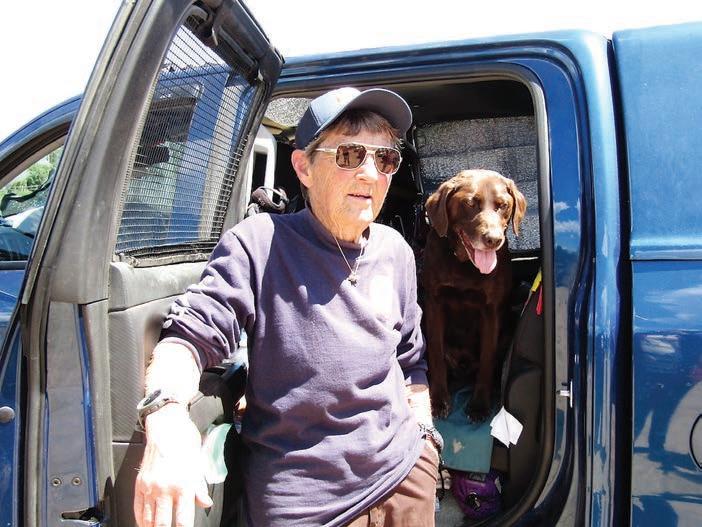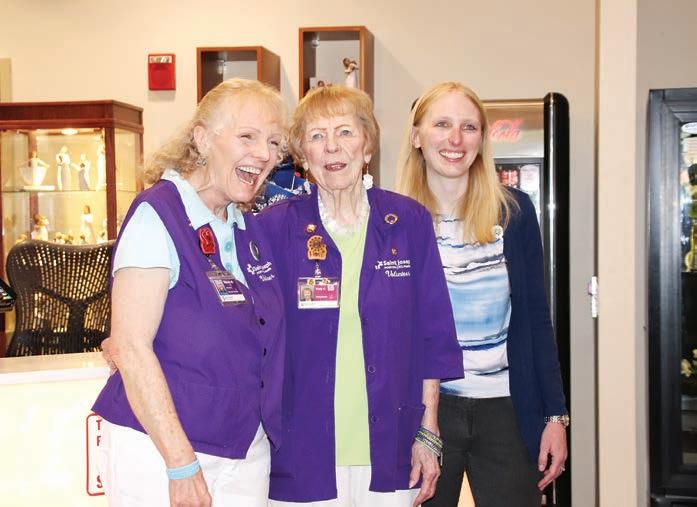
14 minute read
A space for BIPOC moms to discuss parenting

The Black Millennial Mom Podcast wraps up season one
BY CHANCY J. GATLIN-ANDERSON SPECIAL TO COLORADO COMMUNITY MEDIA
At the height of the pandemic in 2020, Denver-based radio personality Mercedes Howard was pregnant with her rst child. She was living in Denver, but most of her family was in California where she grew up.
Like many people around the world during quarantine, Howard found the experience isolating and lonely. On top of the uncertainness that came with the COVID-19 pandemic, Howard was trying to maneuver her rst pregnancy journey without a support system and was feeling scared about the future. erefore, she often turned to TikTok and Google for pregnancy and parenting advice. She found that many pregnant millennial women her age were going through the same struggle. is sparked the idea for Howard to begin a podcast that focuses on millennial moms of color.
“Many millennial mothers I have met are the rst in their inner circle to actually have a child, and their relationships with close friends has now become distant, leaving them to feel more alone,” said Howard. “Other moms I know are struggling with the internal feeling of not being able to provide in the current economy — some being single and having to do a balancing act with parenting, work and sometimes school. In my opinion, the pressure that I have seen in this generation for moms has essentially increased e Black Millennial Mom Podcast promotes discussion about parenting, pregnancy and millennial




“When we create spaces where moms in BIPOC communities share their experiences and assist each other along the way, we nurture greater access to valuable tools and support systems that bene t so many parents and caregivers across Colorado,” said Wendy Allen, manager of Rocky Mountain PBS Kids, in Howard wanted to bring her personal Black experience to the podcasting world. So instead of creating just another mommy-centric podcast, she wanted to create a space for BIPOC women to have safe, informative discussions on issues that are prevalent in the community.
Mile High Happenings is a monthly column featuring community events in Denver, highlighting events in the central and central-south neighborhoods covered by the Washington Park Profile and Life on Capitol Hill newspapers.


Event submissions from community members and local organizations are welcome. Submissions should include brief details about the
June 9-Aug. 13
Code Blue: The Ocean


Time: Gallery hours: 1-4 p.m. Thursday through Sunday, 5-9 p.m. First Fridays, 5-8 p.m. Third Fridays.
Location: Niza Knoll Gallery, 915 Santa Fe Drive, Denver.
Cost: Free.
Running in conjunction with National Ocean Month, “Code Blue: e Ocean” is an exhibition featuring artwork inspired by the ocean, marine life and coral reefs. It is a collaboration of seven local artists: Victoria Eubanks, Judy Gardner, Deborah Jang, Shari Regenbogen, Bonnie Ferrill Roman, Rik Sargent and Caitlin Zeller. A meet the artists reception takes place from 5-8 p.m. June 16. Conversation and stories about coral reefs with Shari Regenbogen Ross, an artist and coral crusader, takes place from 2-3 p.m. Aug. 6.

More information/reservations: nizaknollgallery.com
“Coral Reef” by Rik Sargent. Photo courtesy of an online press kit from Niza Knoll Gallery.
July 9 and Aug. 6
Streets Denver
Time: 8 a.m. to 2 p.m.
Location: Broadway from Alameda to 20th Street, and Welton Street from 20th Street to Five Points.
Cost: Free.
Being put on by the Downtown Denver Partnership and the City and County of Denver, this new, family-friendly event entails closing about 3.5 miles of Broadway and Welton Street so people can enjoy local neighborhoods, businesses and entertainment while walking, biking, rolling, jogging, scooting and dancing in car-free streets. ¡Viva! Streets Denver dates are May 14, June 4, July 9 and Aug. 6. More information/reservations: vivastreetsdenver.com.
event and a photo or event logo. Deadline is the 20th of each month for the event to be listed the following month. Submissions can be emailed to Christy Steadman at csteadman@coloradocommunitymedia.com.
For more Mile High Happenings, visit lifeoncaphill.com or washparkprofile.com.
July 21
Candlelight concert: A

Tribute to Selena at St. Cajetan’s
Time: 6:15 p.m. and 8:30 p.m.
Location: St. Cajetan’s on Auraria Campus, 101 Lawrence Way, Denver.
Cost: $35-$60
Candlelight concerts are a multisensory live music experience. is one will feature the music of Selena performed by e Adelaide Band. e concert is for ages 8 and older, and attendees younger than 16 must be accompanied by an adult.
More information/reservations: feverup.com/en/denver/candlelight Image courtesy of the Candlelight Concerts in Denver webpage on the feverup.com website.
July 20 and July 21-23
Colfax Indie Bash andIndependents Day
Time: Varies.
Location: Colfax Avenue in Denver.
Cost: Free.
There are two events that celebrate everything local that are happening on Colfax Avenue from July 20-23. The weekend will kick with Colfax Indie Bash from 6-9 p.m. July 20 at Bruz Off Fax, 1495 York St. in Denver. This event will highlight food and drinks from local businesses, live music, art and the annual Characters of Colfax awards. This is a free event, but RSVPs are required. Independents Day takes place July 21-23. This event includes local businesses offering specials and promotions, pop-ups from local artists and performers, and a scavenger hunt that provides a tour of the latest public art.
More information/reservations: colfaxave.com/ independents-day
Jul 21-Aug. 10
Visible Planets: Renowned Rappers and their Visual Art
Time: Varies.


Location: Bitfactory Gallery, 851 Santa Fe Dr., Denver.
Cost: Free entry for the art show, concert tickets sold separately. is show is the brainchild of Denverbased visual artist Dan Drossman and rapper Homeboy Sandman of New York, and features a variety of artists and rappers for a two-day event that includes an art show and concert. e free opening reception for the art show takes place at 6 p.m. July 21. e main two-day event takes place beginning on Aug. 4 with the free Visible Planets Art Show Artist Reception from 6-9 p.m. at Bitfactory Gallery. e Visible Planets Hip-Hop Show takes place at 8 p.m. Aug. 5 at Herman’s Hideaway, 1578 S. Broadway, in Denver. Concert tickets cost $35 if purchased in advance and $40 on day of show. Tickets can be purchased online at HermansHideway.com. e concert is an 18+ event. e event is sponsored by KGNU, Artist Proof Collective, Abstract Denver and Ashley Garrett. More information/reservations: bitfactory.net; @ visibleplanets2023 on Instagram
“Airport” by Aesop Rock. Photo courtesy of an online media kit.

July 22-23
Colorado Dragon Boat Festival
Time: The festival takes place from 10 a.m. to 7 p.m. on July 22, and 10 a.m. to 5 p.m. on July 23. Race start time is 8 a.m.
Location: Sloan’s Lake Park, 5055 W. 17th Ave., Denver.
Cost: Free.
e Colorado Dragon Boat Festival is an annual event in its 23rd year celebrating Asian and AsianAmerican heritage. In addition to the boat races, the festival will include live art demos, three stages of performing arts and live music, the Asian Marketplace featuring a variety of vendors and crafts, and the Taste of Asia food vendor booths.
More information/reservations: cdbf.org
Image courtesy of the Colorado Dragon Boat Festival’s website. Artwork by Jamison “Jamey” Padilla.

July 29
Denver Arts & Venues Cultural Runway Series: FashionAbility
Time: 7 p.m.
Location: McNichols Civic Center Building, 144 W. Colfax Ave., Denver.
Cost: VIP $44.80; General Admission Rows 2-3 $25.40; General Admission Standing $8.80 (as listed on tix.axs.com) is Cultural Runway Series fashion show will highlight clothing designed with ability and disability in mind. It will showcase designs by Lexie Bader, Rachael Levine and Rob Hill. A Vendor Market is included, which will feature o erings by artists and designers with disabilities. is fashion show coincides with the “Vibrant Accessibility” exhibit, which is free and open to the public, and runs through Aug. 27.
More information/reservations: mcnicholsbuilding.com
Image courtesy of the Denver Arts & Venues Cultural Runway Series’ webpage.

July 29
History Colorado’s Tours and Treks: The Wonders of the Whittier Neighborhood Walking Tour
Time: 9-11 a.m.
Location: Whittier neighborhood in Denver.
Cost: $40 nonmembers, $30 for members.


is walking tour will explore Denver’s Whittier neighborhood and the numerous changes of its cultural and economic makeup over the decades. It is a moderate walking tour that includes about two miles on streets, easy trails and climbing stairs. Attendees will provide their own transportation to the starting location.
More information/reservations: historycolorado.org/toursand-treks
Aug. 4-6

Denver Days
Time: Varies.
Location: Multiple.
Cost: Free.
July 29-30
VegFest Colorado
Time: 10 a.m. to 6 p.m. July 29, 10 a.m. to 5 p.m. July 30
Location: Tivoli Quad on Auraria Campus, 1000 Larimer St., Denver.
Cost: Varies (daily, weekend and weekend VIP passes available)
VegFest Colorado celebrates “plant-based living, respect for our planet, sustainability and kindness toward our fellow earthlings,” states its website. is all-vegan event will feature more than 100 vendors and no animal products of any kind will be sold, served or sampled.
More information/reservations: vegfestco. com
Logo courtesy of the VegFest Colorado website.
Aug. 1
History Colo- rado: Colorado Day!

Time: 10 a.m. to 5 p.m.
Location: History Colorado Center, 1200 N. Broadway, Denver.
Cost: Free.
History Colorado is inviting the community to a free, family-friendly event to celebrate the state’s 147th birthday. (Colorado entered the Union on Aug. 1, 1876.) e carnivalesque celebration will include arts and crafts, live music, snacks, alpacas and much more.
More information/reservations: historycolorado.org
Image courtesy of the event’s page on History Colorado’s website.
Getting its start about 11 years ago, Denver Days is a time for neighbors to connect and get to know each other. Events take place across the city and can include block parties, community picnics and small-area service projects, for example. ose wanting to host a Denver Days event must register their event by July 21. (Permit fees for park picnics and block parties are waived.) ose wanting to attend a Denver Days event can nd a list of registered events on the webpage below.
More information/reservations: tinyurl.com/DenverDays2023
Logo courtesy of the Denver Days 2023 webpage on the city’s website.
BY DEB HURLEY BROBST DBROBST@COLORADOCOMMUNITYMEDIA.COM
Search-and-rescue dogs embody the mail carrier motto: “Neither snow, nor rain nor gloom of night” will keep these trusty canines from their appointed rounds — searching for people or items with single-minded purpose.
For the dogs and their trainers who are part of the Colorado branch of SARDUS — Search and Rescue Dogs of the United States — training is a weekly, if not daily, endeavor to prepare dogs to certify in an area of search and rescue or to keep the dog’s skills sharp after certi cation.
“ e training continues for life,” said Cathy Bryarly, a retired Boulder sheri ’s deputy who trains search-and-rescue dogs. “ is has to be part of your life. It goes way beyond a hobby, or it’s not going to work. It’s a calling.”
SARDUS members agree that it’s a labor a love based in their strong resolve to help others. Not only do the dogs and their handlers train multiple times a week, enlisting family and friends to hide, so the dogs have someone to search for, but handlers also attend seminars on a variety of topics and work together by laying trails for others to follow.
Trainers are always learning, so they can improve their canines’ ability to help in emergency situations.
Search-and-rescue dogs and their handlers are not paid; in fact, handlers spend a lot on the dogs, the equipment, the training and more. e goal is to be certi ed to go on missions, the term for helping law enforcement nd people, bodies or objects needed in an investigation.
Call the people trainers or handlers, but more importantly, they’re dog lovers who want to work as a team with their pets to help others.
The humility of training e trainers say it simply: Training their canines is humbling.
“Our dogs don’t make the mistakes,” Anjie Julseth-Crosby of Morrison said. “We do. ere’s so much to remember. e training is about me trying to understand what (the dogs) are saying. e human fails, not the dog.”
In fact, Julseth-Crosby, who started training her bloodhounds two years ago, has compiled a 19-page document called “ ings I wish I knew two years ago.”
Training involves having a dog follow a scent for several miles, helping the dog return to the
SEE DOGS, P15
Types Of Sardus Certifications

• Trailing: Dogs who can find scents by putting their noses to the ground.
• Air scenting: Dogs who find scents by putting their noses into the air.
• Avalanche: Some dogs are good at smelling human scents through snow.
• Water: Some dogs are good at smelling human scents through water.
• Disaster search: Dogs can smell through debris to find people.
• Human remains: Dogs can be certified to find human remains.
• Wilderness: A type of trailing in remote areas.
• Urban and suburban: Looking for missing children or older adults in cities.
scent trail if needed and rewarding the dog when it nds the person or item it is directed to follow.
Training can be messy as canines follow the scent wherever it takes them over all sorts of terrain in all kinds of weather.
Julseth-Crosby said the number of hours can be whatever trainers can put in, but at a minimum eight hours a week, and some weeks, she trains or prepares for training as much as 40 hours a week.
The right breed
While just about any breed of dog can become a search-and-rescue dog, bloodhounds, shepherds and retrievers are the typical dogs people think of, but other breeds — if they have the nose for the work — can be certi ed.
“It works better to start with a breed that is bred to do this,” Bryarly said. “In fact, there are some breeders who breed speci cally search-and-rescue dogs. But sometimes you nd a dog that is good at this, and it’s a breed you never would have guessed could do this work.” e most important thing, Bryarly said, is the bond that the dog and handler have with each other.
“People have told me over the years that they are amazed at something their dog does,” she said. “People think they are the smart ones, but the dog is the smart one. We are just trying to keep up with them.”
Starting early
Training starts early — when pups are a few weeks old.
“Start with a dog who has a high drive,” Bryarly said. “A high-drive dog is always busy and always wanting something to do. If that energy is not channeled right away, the pup will tear your house apart.”
Most canines prefer one of two types of rewards: food or toys. Once you gure that out, then trainers must convince the dog to do what they want the pup to do for the reward. It begins with what is called a puppy run-away, where you get the pup to run after a person, and when the pup nds the person, the pup gets a reward. at transitions to following a scent to nd a person.
“It’s just a matter of making it harder and harder to the point where a dog is searching 120 acres for one person or that trailing dog is following a 24-hour-old scent through a subdivision,” Bryarly said.



No matter what or who the dog is nding, it must go to it, stay there, lay down and point its nose, so the handler knows the dog is saying that the item or person is there.
Dogs cannot certify to be searchand-rescue dogs until they are at least 18 months old, but it usually takes two years or more for the rst certi cation, Bryarly said.
“Search-and-rescue dogs that are out in the public have to be just perfect,” Bryarly said. “ ey have to stay focused and not get distracted by other dogs, animals or people.”
Getting involved irty years ago, Julseth-Crosby made a pledge that she would own a bloodhound and train it to be a search-and-rescue dog. at’s because Ali Berelez, 6, who had been kidnapped and murdered in 1993, was found four days after her abduction by bloodhound Yogi.
Julseth, at that time a single parent with a 6-year-old, felt kinship with Ali’s family. However, as a full-time teacher, Julseth-Crosby decided to wait to train when she retired in 2021. True to her word, she began training her bloodhounds Bruno and Miley.
Niamh Coleman of Nederland was looking for something to do with her dogs, thinking it was a casual pastime. Now search-and-rescue dog training is closer to an obsession.
Melanie Weaver of Lafayette knew her dog, Lego, a German shepherd, needed a job to have a ful lling life, and Weaver was looking for something practical. Little did she know that training Lego would be a multiple-day-a-week job.
Jayne Zmijewski, who taught outdoor skills to rangers most of her life, said search-and-rescue dogs were a natural progression. She’s had four search-and-rescue dogs in the last 30 years, most recently her chocolate Labrador Kodi.

Teresa Verplanck of Bailey is training Lilo, a border collie mix, for wilderness searches. She called the SARDUS group she trains with wonderful, and trainers and dogs have become a big family.
Jake Udel, who lives near Rustic, Colorado, is a volunteer firefighter and medic, and he trains his dog, Java the Mutt, a Czech shepherd, “for the love of dogs, helping people and the activity.”
Udel figures he’s been on 75 to 100 missions since he certified his first dog in 2005.
SARDUS
SARDUS, one of several searchand-rescue dog organizations in the country, helps smaller organizations test and certify dogs. To get the trailing or air-scent certification, which is usually the first certification a dog earns, the canine must follow a 24-hour-old trail to find a person. SARDUS only works with law enforcement, so a person cannot request a searchand-rescue dog.
Bryarly said about 30 dogs in Colorado are certified by SARDUS with most of them trailing dogs — the most of any organization in the country.
Membership in SARDUS is $25, and some people join who don’t own dogs, but they want to help in other ways such as creating tracking trails or hiding from dogs, Bryarly said.
Trainers must be physically fit since they follow their dogs through all sorts of terrain, plus they take classes such as the Federal Emergency Management Agency’s incident command courses, so they understand the structure of incidents and managing evidence.
For the SARDUS trainers, the work is definitely a passion.
“If you think of it as work, you won’t do it for 20 years,” Udel explained. “You have to adopt the (search-and-rescue) lifestyle. It’s a life-and-death commitment for some people — certainly the people we are looking for.”
BY CHRISTY STEADMAN CSTEADMAN@COLORADOCOMMUNITYMEDIA.COM




Polly Coleman donned a huge smile as she walked into Saint Joseph Hospital to begin her volunteer shift.
Coleman celebrated her 97th birthday the day before. But as she entered the hospital on June 20, about 30 sta and volunteers gathered to celebrate her for a di erent milestone — Coleman had completed 20,000 hours of volunteer work at the hospital over the course of 32 years.


“Volunteers are a big part of what we do here at the hospital,” said Yusuf Hassan, director of volunteers and guest services for the hospital. “She believes in our mission (and) she loves giving back.”
Coleman, of Broom eld, started volunteering at the hospital in Denver’s City Park West neighborhood because she knew she wanted to stay active and involved after retirement. Also, her dad had a friend that was chief of surgery at the time.
So, she began in 1991. Since then, Coleman has volunteered in the surgery waiting room, as a board member, as an event co-chair, as a mentor and trainer, and much more.
Hassan recalled that Coleman loves serving at the hospital so much that during the COVID-19 shutdowns — when nobody but patients and sta were allowed in hospitals — Coleman was one who called every day asking when she’d be able to come back.
Currently, Coleman spends two days a week in the hospital’s gift shop. “It’s because of love,” Coleman said. “I love what I do.”
Supporting Saint Joseph Hospital has become somewhat of a tradition for Coleman’s family, as there are three generations who dedicate time. Coleman’s granddaughter, Sarah Owen, started volunteering at the hospital when she was 12, simply to be able to hang out with her grand- to the hospital gives her an additional sense of purpose,” Owen said. “She’s there (in the gift shop) with a smile, getting to know everyone.” e hospital hosts a variety of volunteers — people who dedicate their time to do everything from communion to pet therapy. e hospital has about 162 active volunteers who, combined, provide an average of 1,500 hours per month. is equals the work of nine-and-a-half full-time employees and pay value equivalent to $50,000, Hassan said. e gift shop is run completely by volunteers, and since 2012, it has invested $1.33 million into the hospital, Hassan said. e volunteers are “extremely valuable,” Hassan said. “And not only the dollar value. Just their presence alone makes such a di erence.”

He added that while Coleman’s 32 years is the longest out of all the volunteers, there are about 10 who have been volunteering at Saint Joseph Hospital for more than 20 years, and several more who have been volunteering at the hospital for more than 10 years. Nine volunteers are former employees.









